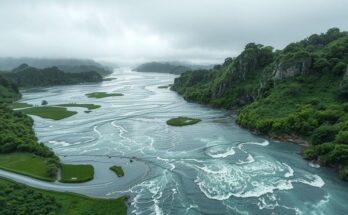Japan’s government estimates that a future megaquake could inflict US$1.81 trillion in damages and result in approximately 300,000 deaths. The report reflects updated data and inflation-adjusted economic projections, highlighting the country’s vulnerability given the seismic activity along the Nankai Trough and the historical context of past quakes.
Japan’s latest government report indicates that a potential megaquake off its Pacific coast could lead to an economic loss of approximately US$1.81 trillion. This figure, equivalent to 270.3 trillion yen, accounts for nearly half of the nation’s gross domestic product (GDP) and signifies a substantial increase from the previous estimate of 214.2 trillion yen. The revision is attributed to inflationary pressures alongside updated data regarding terrain and ground conditions that have affected anticipated flood zones.
Recognized as one of the world’s most seismically active nations, Japan faces about an 80 percent probability of experiencing a magnitude 8 to 9 earthquake along the Nankai Trough. Should a worst-case scenario manifest, which involves a potential magnitude 9 quake, the country could see approximately 1.23 million evacuees, representing about 10 percent of its overall population. Tragically, estimates suggest that up to 298,000 individuals might perish in such an event, particularly if it occurs during the night in winter.
This tectonic zone, located off Japan’s southwest Pacific coast and extending roughly 900 kilometers, is characterized by the subduction of the Philippine Sea Plate beneath the Eurasian Plate. Consequently, the strains produced by tectonic activity indicate that a megaquake might occur every 100 to 150 years. In a precautionary move, Japan issued its first megaquake advisory last year, highlighting a “relatively higher chance” of a magnitude 9 quake in the area following a nearby magnitude-7.1 earthquake.
The catastrophic impact of a magnitude 9 earthquake was starkly demonstrated in 2011, when one such quake triggered a deadly tsunami and resulted in catastrophic failures at a nuclear power plant in northeastern Japan, leading to over 15,000 fatalities.
The government report underscores the significant risk Japan faces from seismic activity, particularly the potential for a devastating megaquake. With estimated losses soaring to US$1.81 trillion and the possibility of significant casualties, the findings emphasize the urgent need for continuous disaster preparedness and response strategies to mitigate the potential human and economic impact of such natural disasters.
Original Source: www.channelnewsasia.com




